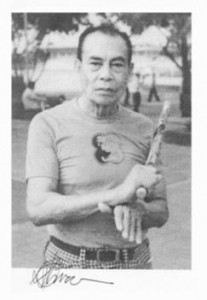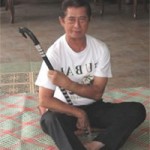
Interview With GM Antonio “Tatang” Illustrisimo and Master Tony Diego
This interview was conducted with Antonio Tatang Illustrisimo and his senior student, Tony Diego, on July 29, 1997, in Manila, for Australasian Fighting Arts Magazine. It was the last interview the Granmaster ever gave. At the time of the interview, Grandmaster Illustrisimo had been ill for the previous two weeks, so he tired quickly and had some trouble talking. We were accompanied by a live-in companion, who helped serve as a translator for some of the Grandmasters answers. He passed away about a month after this interview was conducted.
Grandmaster Illustrisimo lives in one of the toughest sections of Manila, near the docks. He was a merchant seaman for 35 years, and has spent his life in this same area. As an example of the respect these people give to this legend, the story is told of a gang fight between a local Manila-born gang and a gang of men who had come from the Visayan Islands for work. At the height of the melee, with many men fighting, Tatang walked through the middle of the place, and everyone stopped fighting until he had passed. He is one of those rare men whose reality justifies the legend.
Australasian Fighting Arts Magazine: Erle Montaigue visited you in Manilla around 1981 and was impressed with what you were doing. He wrote an article for Australasian Fighting Arts magazine at that time. I am happy to see that you are still enjoying life and your students. And also happy to see that most of the students that you were teaching back then are still with you. Have your ideas on your training methods changed at all since 1981?
GM Illustrisimo: The principles of the Art are still the same principles, so of course it is the same.
AFM: When you began teaching your students, like Antonio Diego, you had certain ideas as to what they would learn by now. Have they reached your expectations?
GM Illustrisimo: Yeah! Tony has been with me a long time, since 1975. If you want to train with me, you must learn the old way. When we train, I will hit your hands, many times, so you learn. You must take the pain to learn.
AFM: Tony Diego, youve been with GM Illustrisimo for more than 20 years. Have you been satisfied with your training in the art, and with Tatang?
Tony Diego: At first, he wouldnt teach me. He said that the Art was only for fighting. I kept asking and finally he accepted me. Ive been very satisfied. I have never felt that I wanted to change, or stop training. At one time, I was a little frustrated, though, and I asked Tatang why I couldnt be more like him. He simply answered that You are you, you are not me. Everyone learns in a different way, so you must be satisfied with the result that you get. It cant be the same as your teacher.
AFM: Do you feel like you have mastered everything the grandmaster has to teach?
Tony Diego: Once I asked Tatang if he had taught everything, if I had the complete system. He replied, When a guest comes to your house and you give him food, you give him the rice from the top of the pan. Its the best rice that everyone likes to eat, but you save for yourself the rice from the bottom of the pan, where it has become hard and crusty. I think that means that he taught everything he could teach, but that there are things that he still has that are not teachable. Things that come from an individuals experience in life.
AFM: Tony, you will retire from your job in a few years. Do you think tht you will take on more students, expand the teaching?
Tony Diego: No. I dont think so. I have several students who have been with me for many years. Probably they will take over the job of passing on Kali Illustrisimo.
AFM: GM Illustrisimo, your style of Arnis impressed Erle Montaigue as one of the most natural for self defense. Are your views still the same in that this art should only be for self defence using straight forward methods rather than the more flowery ones?
GM Illustrisimo: The fancy stuff in arnis, all the flowery movements, is only for stage shows, for demonstrations, not for real fighting.
AFM: What is your advice to students who would wish to take up arnis nowadays in the Western world? It seems that today, the old ways of learning are fading, and many students want to learn the tournament styles.
GM Illustrisimo: Arnis is simple, only one-two-three (demonstrating a 3-strike combination in the air). The tournament styles are different, not really arnis.
AFM: How long do you feel a student needs to train to learn arnis, how many years?
GM Illustrisimo: Only two weeks, you can master the techniques! Arnis is simple, only one-two-three!
AFM: Two weeks!!?
GM Illustrisimo: Study with me one hour every day and you can learn how to fight for tournaments. My pupils usually win in the tournaments. Remember, though, that training for tournaments is not training for real fighting. Wearing armor is bad for the art, students dont learn well.
AFM: Since Erle Montaigue saw you in 1981, his own art has changed much with time. Is it the same with your arnis. Have your methods changed as you have become older?
GM Illustrisimo: When fighting, you only adjust to your opponent, to what he does. As you get older, you still must adjust. Maybe you do something differently than when you were younger, but it is just an adjustment to the situation. Age is just one part of the situation.
AFM: Does that mean that you feel that the inevitable physical decline that comes with age can be adjusted for? Does someones increasing skill and experience compensate for physical decline?
GM Illustrisimo: Yes.
(An aside here, to illustrate the point. When Tony Diego first introduced me to GM Illustrisimo, he playfully attacked Tatang. The grandmaster was holding two canes at the time, one to help him walk, and a shorter rattan. Even though he does not see well anymore, and he is 90 years old, his reaction to even the playful attack was immediate, very fast, and obviously exactly right to defend himself.)
AFM: Lets change directions now. In your lifetime, who were the best arnis players you can remember, the very best ones?
GM Illustrisimo: Here in the Philippines, no one would fight me. I had fights in Singapore and in Jakarta with good players. The toughest one was in Singapore. I cut him across the right wrist and won the fight, and $5000. I also fought in Calcutta, and broke that mans right arm.
AFM: Besides yourself, then, here in the Philippines, who were the great ones?
GM Illustrisimo: My father, my grandfather and the brother of my father were all great fighters.
AFM: So you learned from your father and uncles.
GM I: Yes.
AFM: Who was Pedro Cortes? Did you learn anything from him?
GM I: Yes, he was the sparring partner of my father, from Mindanao. His style was much like the Illustrisimo style, same as my father.
AFM: What about some of the famous names everyone has heard about? People like Dizon, Villabrille, Cabales? Did you know them when you were all younger?
GM I: Yes, we were all here in Manila. Villabrille was my cousin.
AFM: Did you teach Cabales anything?
GM I: Yes, but I didnt like his techniques.
AFM: Did you ever fight with Cabales, or the others?
GM I: Yes, we often played, but they wouldnt fight with me for real.
AFM: So you had a reputation even then, when you were a young man. What other fights have you had?
GM I: Yes. No one wanted to fight me. In the early 50s, I had a real fight, not an arranged match, with a man called Doming here on Dock 8. He had a knife and I picked up a short piece of pipe from the ground. He died from a blow to the head with that pipe.
AFM: Ive heard that you have another nickname. Dagohoy, is that correct?
GM I: Yes, it is only a nickname.
Tony Diego: Dagohoy was a famous fighter from the island of Bohol who led the people in an uprising. He was a famous fighter in our history, so people call Tatang this name as well, a name of respect.
AFM: Dan Inosanto is very well-known in martial arts circles. One of his main teachers was John LaCoste. Did you know John LaCoste here before he went to the US?
GM I: No, I didnt know him.
AFM: What about the fighters from Cebu? The Canetes, the Saavedras, etc. Did you know them, or ever fight anyone from Cebu?
GM I: No, I never fought them, but I dont like their techniques. The Cebu fighters like to use the abanico techniques to the head. No good!
AFM: In your art, you train to use a blade. Does that change how you use a stick?
GM I: Its the same, no different.
AFM: There was a famous match arranged once between Joe Mena and Cacoy Canete. Can you tell me what happened?
GM I: They began to fight, but someone interfered and the fight was not resolved, no winner.
AFM: Ive heard that you began training when you were 9 years old. That would have been in about 1916. How was the training different then, from the way it has become recently?
GM I: It was very different. It was only practical training then, learning how to survive.
AFM: During World War II, you were a guerrilla fighter. There are several stories about that time. Can you tell me about some of them?
GM I: Yes, I was fighting against the Japanese. I killed 7 Japanese with my blade.
Tony Diego: There is another good story about that time. One night, Tatang and a friend had been drinking and were walking home when they came upon a single Japanese sentry, standing guard. Tatang walked right up to the man and pulled his samurai sword out of the scabbard, looked at it, put it back and walked away. The Japanese soldier was so surprised that he didnt do anything, even though he had a gun,
AFM: GM Illustrisimo, youve had a very long and eventful life. Is there anything you regret, or anything you would like to change?
GM I: Nothing. Ive been happy.
AFM: Erle Montaigue has asked me to tell you that it was a great pleasure and honour to meet you back in 1981 and he that he has often thought about you since then. It has also been an honor for this interviewer to have met a genuine legend of the Filipino martial arts. Thank you for the great knowledge that you have given the martial arts world.

















